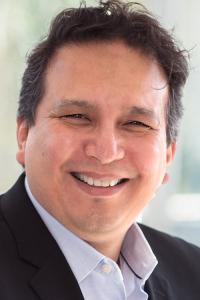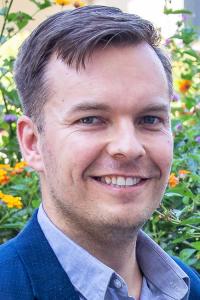Quick Summary
- John F. López is researching “The Aquatic Metropolis”: Mexico City
- Jonathon Schofield seeks to expand amputees’ use of bionic protheses
- Donor-funded endowment earmarks the awards for early career faculty
One is an art historian who is researching a book on the centuries-old efforts by the Aztec and Spanish to combat catastrophic inundation in the “aquatic metropolis” of Mexico City. The other is an engineer who has teamed up with UC Davis Medical Center physicians to improve amputees’ control over their bionic prostheses.
RELATED CONTENT
- Chancellor’s Innovation Awards for 2021, recognizing faculty, project teams and community partners for their work, dedication and success in improving the lives of others and addressing the needs of our global society through innovative solutions.
Each of these assistant professors won $40,000 to support their work, as recipients of the UC Davis’ 2021 Early Career Faculty Awards for Creativity and Innovation.
They are John F. López, Department of Art and Art History, College of Letters and Science; and Jonathon Schofield, Department of Mechanical and Aerospace Engineering, College of Engineering.
Donors wishing to remain anonymous established the creativity and innovation awards with an endowment. The awards, given annually since 2016, are designated for nontenured ladder-track faculty.
‘The Aquatic Metropolis’

This comparative study — full title “The Aquatic Metropolis: Mapping Nature and Urban Aesthetics at Viceregal Mexico City” — “balances an art historian’s close reading of visual and material culture with the methods of historians of cartography, science, technology and the environment to explicate a more nuanced understanding of Mexico City’s historical path of development than previously offered,” López wrote in his proposal. “Underpinning this study is the visual culture of water — maps, drawings and paintings made by European and indigenous artists.
“Unlike the Aztec, who built a city of causeways, dikes and floodgates to mitigate environmental disaster, the Spanish undertook drainage (desagüe in Spanish), an approach predicated on subjecting New World nature to European rational — scientific, technical and empirical — analysis to overcome the city’s geography, thereby transforming Mexico City from island to mainland settlement.
“Thus, in scrutinizing the broader implications of a Spanish response to environmental crisis, this research sheds light on how a shift from Aztec causeways to Spanish drainage speaks to a new epistemological orientation to nature that had transformative urban implications.”
López joined UC Davis in 2017. He holds a Bachelor of Architecture degree, a Master of Arts degree in international studies and a Master of Architecture degree, all from the University of Oregon; and a Ph.D. in history, theory and criticism of architecture and art from the Massachusetts Institute of technology. He was a lecturer and postdoctoral scholarship recipient at the University of Chicago and served as an assistant professor at Skidmore College before coming to UC Davis.
Earlier this year he received an award from the American Council of Learned Societies, allowing him to take a yearlong sabbatical to work on his book project.
Restored muscle movements

Schofield, whose research aims to improve user acceptance and promote the seamless integration of humans and assistive medical devices, noted in his proposal a recent surge of dexterous robotic prostheses that closely resemble the form and function of intact upper limbs. “However, their lack of intuitive control remains a driving factor in their high rates of user abandonment,” he said.
In response, experimental control techniques that derive signals from the user’s nervous system have emerged — including targeted innervation, or TR, a rewiring of the nerves in hand/limb stumps, giving patients control over their prostheses by thinking about moving their missing limbs.
Schofield is collaborating with the surgical team of Clifford Pereira, Chetan Irwin and Andrew Li at UC Davis Medical Center, one of the few hospitals in the world that has begun performing TR surgery.
“Current literature describes patients with TR surgery and bionic prostheses long after amputation and surgery,” Schofield wrote. “However, little is known about the critical first year in which patients are healing [and] rehabilitating, and their nerves are regrowing. Here, understanding how patients progressively gain control over their newly reinnervated muscles has important implications to informing the timing of rehabilitation strategies and prosthetic prescriptions, and in the development of adaptive prosthetic control techniques to insure the most successful outcomes for these individuals and their bionic prostheses.”
Schofield joined UC Davis in July 2019. He earned a Bachelor of Mechanical Engineering at Lakehead University, Canada, before going to the University of Alberta, where he earned a Master of Science degree in biomedical/structural engineering, and a Ph.D. in biomedical/mechanical engineering. He did postdoctoral work in biomedical engineering at the Cleveland Clinic Lerner Research Institute before coming to UC Davis.
Media Resources
Dateline Staff: Dave Jones, editor, 530-752-6556, dateline@ucdavis.edu; Cody Kitaura, News and Media Relations specialist, 530-752-1932, kitaura@ucdavis.edu.